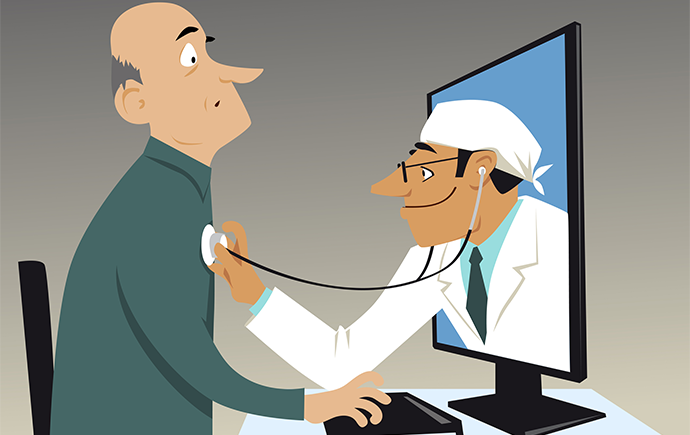Tennessee Health System Looks to Use Telehealth, RPM Beyond Covid-19 Care
West Tennessee Healthcare has seen success using a remote patient monitoring platform to treat COVID-19 patients at home. Now it's planning to modify the platform for chronic care management.

Source: ThinkStock
- A telehealth platform launched last July at West Tennessee Healthcare to monitor COVID-19 patients has proven so good at boosting outcomes and reducing hospitalizations that officials are now planning to expand the program.
“There’s a lot more that we can do with this,” says Claude Pirtle, chief medical information officer for Jackson-based six-hospital health system. “We just have to get used to it.”
Like so many health systems in 2020, telehealth and especially remote patient monitoring were new concepts for WTH. Pirtle says the health system was planning on working inpatient and outpatient virtual care into the system gradually through 2020 and 2021, and taking the time to get both staff and patients up to speed on the new technology and services.
COVID-19 changed everything, forcing hospital administrators to “hit the ground running” on programs to monitor patients both inside and outside the hospital. For less-acute COVID-19 patients, the health system chose an RPM platform from Masimo that allowed them to track vital signs at home through an mHealth device.
Pirtle says the health system wouldn’t have been so receptive to telehealth and RPM had not state and federal officials take action to improve telehealth coverage during the coronavirus pandemic. Payment parity “was a huge win for us,” he says, as were emergency measures designed to expand coverage for more care providers and telehealth services.
READ MORE: Mount Sinai Extends Cancer Care to the Home With New Telehealth Program
This story really isn’t any different than that of hundreds of other hospitals and health systems across the country, if not the world. But as Pirtle points out, it isn’t the same, either. Each care provider has to approach connected health with an eye toward specific services and benchmarks that can’t be copied from another hospital’s playbook.
“The biggest challenge for us is that it was all new,” he says. “The first step for us was education, education and education. We had to learn what we could and figure out what would work” for the health system’s needs and population base.
Pirtle says the health system realized almost immediately that the RPM program wouldn’t work without full buy-in and support from its nurses, who help the patients become acclimated with the devices and monitor them 24/7 from afar. That meant bringing them on board from the beginning, listening to their concerns and developing workflows around them, rather than forcing them to adjust.
“There wasn’t a lot of information out there for us to work with,” he says. “We listened to them (as we) created new responsibilities for them and identified the gaps in care that we wanted to address.”
Through its RPM platform, West Tennessee Health sends selected patients diagnosed with COVID-19 home with an mHealth device that capture relevant data and transmits it back to care providers (For those who decline the RMP option, the health system equips patient with basic, unconnected devices and checks in with them on a regular basis by phone). The program is designed to last 30 days, though most patients transition out in about two weeks.
READ MORE: Analysis: CMS Gives Telehealth a Boost, But More is Needed
Pirtle says the health system has treated roughly 800 people through the platform and seen a boost in good outcomes, as well as a significant reduction in hospitalizations. The platform has also helped on-call nurses intervene in four “scary situations,” during which they were able to identify patients in a health crisis and take immediate action.
West Tennessee Healthcare is now expanding the platform from its main hospital to two others in the health system. After that, they’ll modify the platform to monitor patients with congestive heart failure and COPD – “two populations with currently high readmission rates,” says Pirtle. This, in turn, will lead to a more expansive chronic care management platform in the future.
“We want to change the narrative that we’ve been doing for years,” he says. RPM “gives us a chance to work with them and get them involved in their own care.”
The challenges ahead include developing a routine for fine-tuning and tweaking the system when different populations are introduced, so that providers can adjust the platform to track specific data for specific conditions or patients (such as someone with multiple chronic conditions). Pirtle says he’d like to see a platform that can easily integrate more data and connect with the EHR platform, “getting everything you need from the patient in one bucket” and making it easier to scale up and out.
And he’s working with private payers to get them to support RPM coverage, while waiting to see what state and federal policy makers decide with long-term Medicare and Medicaid coverage. Without long-term assurances of coverage, the program might not be sustainable or scalable.
READ MORE: Memorial Hermann Maps Out a Strategy for Primary Care via Telehealth
“It’s still a bit like the Wild Wild West out there,” he says.
West Tennessee Healthcare is hoping to have a hand in that narrative. Pirtle says they’re in the middle of a research study evaluating the effectiveness of the RPM platform, with an eye toward readmission rates, length of stay, quality of care and clinical outcomes.
“COVID-19 kind of put everything on steroids for us,” he says, describing the mad rush to reduce in-person care and put as much as possible onto virtual care platforms. “It gave us a chance to introduce this and see how it works, and we’re just now beginning to understand it. We want to be able to keep on using it.”
